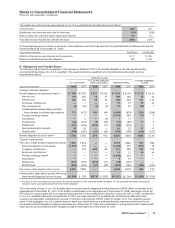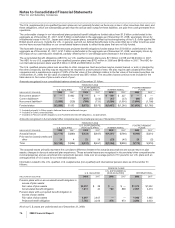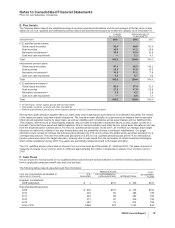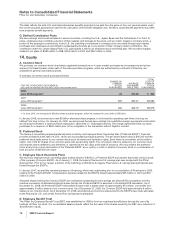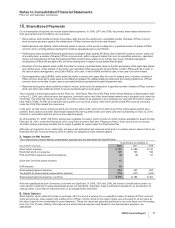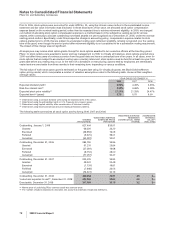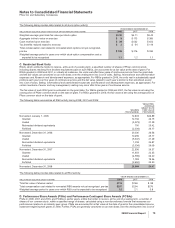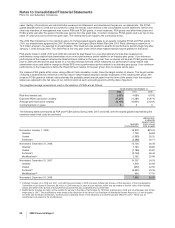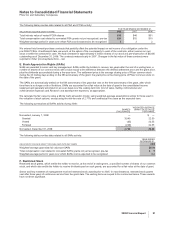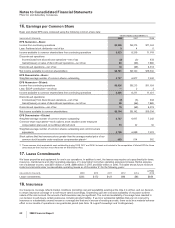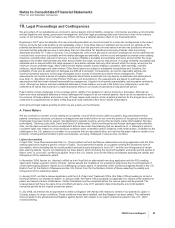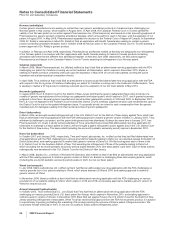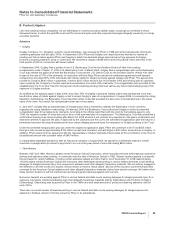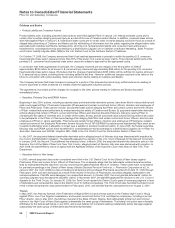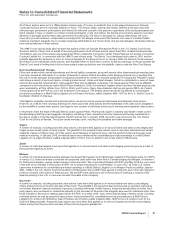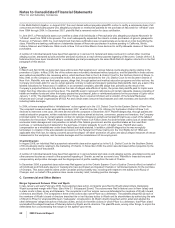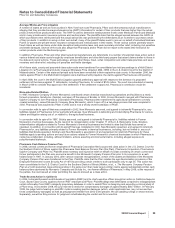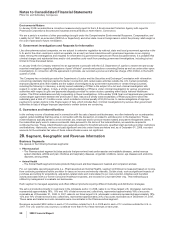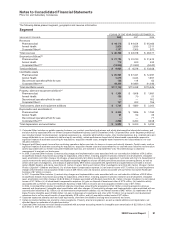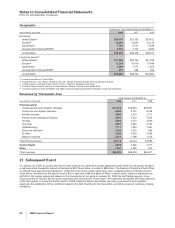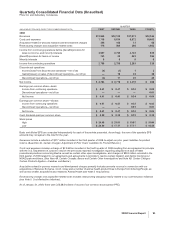Pfizer 2008 Annual Report Download - page 85
Download and view the complete annual report
Please find page 85 of the 2008 Pfizer annual report below. You can navigate through the pages in the report by either clicking on the pages listed below, or by using the keyword search tool below to find specific information within the annual report.
Notes to Consolidated Financial Statements
Pfizer Inc and Subsidiary Companies
19. Legal Proceedings and Contingencies
We and certain of our subsidiaries are involved in various patent, product liability, consumer, commercial, securities, environmental
and tax litigations and claims; government investigations; and other legal proceedings that arise from time to time in the ordinary
course of our business. We do not believe any of them will have a material adverse effect on our financial position.
Beginning in 2007 upon the adoption of a new accounting standard, we record accruals for income tax contingencies to the extent
that we conclude that a tax position is not sustainable under a ‘more-likely-than-not’ standard and we record our estimate of the
potential tax benefits in one tax jurisdiction that could result from the payment of income taxes in another tax jurisdiction when we
conclude that the potential recovery is more likely than not. (See Note 1B. Significant Accounting Policies: New Accounting
Standards and Note 7E. Taxes on Income: Tax Contingencies.) We record accruals for all other contingencies to the extent that we
conclude their occurrence is probable and the related damages are estimable, and we record anticipated recoveries under existing
insurance contracts when assured of recovery. If a range of liability is probable and estimable and some amount within the range
appears to be a better estimate than any other amount within the range, we accrue that amount. If a range of liability is probable and
estimable and no amount within the range appears to be a better estimate than any other amount within the range, we accrue the
minimum of such probable range. Many claims involve highly complex issues relating to causation, label warnings, scientific
evidence, actual damages and other matters. Often these issues are subject to substantial uncertainties and, therefore, the
probability of loss and an estimation of damages are difficult to ascertain. Consequently, we cannot reasonably estimate the
maximum potential exposure or the range of possible loss in excess of amounts accrued for these contingencies. These
assessments can involve a series of complex judgments about future events and can rely heavily on estimates and assumptions
(see Note 1C. Significant Accounting Policies: Estimates and Assumptions). Our assessments are based on estimates and
assumptions that have been deemed reasonable by management. Litigation is inherently unpredictable, and excessive verdicts do
occur. Although we believe we have substantial defenses in these matters, we could in the future incur judgments or enter into
settlements of claims that could have a material adverse effect on our results of operations in any particular period.
Patent claims include challenges to the coverage and/or validity of our patents on various products or processes. Although we
believe we have substantial defenses to these challenges with respect to all our material patents, there can be no assurance as to
the outcome of these matters, and a loss in any of these cases could result in a loss of patent protection for the drug at issue, which
could lead to a significant loss of sales of that drug and could materially affect future results of operations.
Among the principal matters pending to which we are a party are the following:
A. Patent Matters
We are involved in a number of suits relating to our patents, most of which involve claims by generic drug manufacturers that
patents covering our products, processes or dosage forms are invalid and/or do not cover the product of the generic manufacturer.
Challenges have been made by generic manufacturers to patents covering, among other products, Lipitor (atorvastatin), Norvasc
(amlodipine), Celebrex (celecoxib), Detrol and Detrol LA (tolterodine), Vfend (voriconazole) and Aricept (donepezil hydrochloride).
Also, counterclaims as well as various independent actions have been filed claiming that our assertions of, or attempts to enforce,
our patent rights with respect to certain products constitute unfair competition and/or violations of the antitrust laws. In addition to the
challenges to the U.S. patents on a number of our products that are discussed below, we note that the patent rights to certain of our
products, including without limitation Lipitor and Celebrex, are being challenged in various other countries.
Lipitor (atorvastatin)
In April 2007, Teva Pharmaceuticals USA, Inc. (Teva) notified us that it had filed an abbreviated new drug application with the FDA
seeking approval to market a generic version of Lipitor. Teva asserts the invalidity of our patent covering the enantiomer form of
atorvastatin, which (including the six-month pediatric exclusivity period) expires in June 2011, and the non-infringement of certain
later-expiring patents. Teva is not challenging our basic patent, which (including the six-month pediatric exclusivity period) expires in
March 2010. In June 2007, we filed suit against Teva in the U.S. District Court for the District of Delaware asserting the validity and
infringement of the enantiomer patent.
In November 2008, Apotex Inc. (Apotex) notified us that it had filed an abbreviated new drug application with the FDA seeking
approval to market a generic version of Lipitor. Apotex asserts the invalidity of our enantiomer patent and the non-infringement of
certain later-expiring patents. Apotex is not challenging our basic patent. In December 2008, we filed suit against Apotex in the U.S.
District Court for the District of Delaware and the U.S. District Court for the Northern District of Illinois asserting the validity and
infringement of the enantiomer patent.
In January 2007, we filed a reissue application with the U.S. Patent and Trademark Office (the Patent Office) seeking to correct a
technical defect in our enantiomer patent. In January 2009, the Patent Office accepted our application for reissue of the enantiomer
patent and issued a Notice of Allowance. Certain formalities must be completed before the reissue patent will be granted. The
reissued patent will have the same force and effect and same June 2011 expiration date (including the six-month pediatric
exclusivity period) as the original enantiomer patent.
In July 2008, we entered into an agreement to settle our litigation with Apotex with respect to certain of our patents for Lipitor in
Canada, subject to certain conditions. Those conditions have been satisfied, and that litigation has been settled. The settlement
does not apply to the aforementioned litigation against Apotex with respect to our Lipitor enantiomer patent in the U.S., which
remains pending.
2008 Financial Report 83


